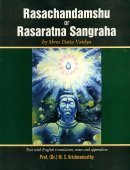Navaratna, Nava-ratna, Navan-ratna: 12 definitions
Introduction:
Navaratna means something in Hinduism, Sanskrit, the history of ancient India. If you want to know the exact meaning, history, etymology or English translation of this term then check out the descriptions on this page. Add your comment or reference to a book if you want to contribute to this summary article.
Images (photo gallery)
In Hinduism
Jyotisha (astronomy and astrology)
Source: Wikipedia: Jyotisha (astronomy)Navaratna (नवरत्न).—According to the ancient “Jataka Parijata”, chap. 2, sloka 21 compiled by Sri Vaidyanatha Dikshitar, these gems must be high-born and flawless:
- Ruby (manikya) for Surya (Sun),
- Pearl (muktaphala) for Chandra (Moon),
- Red Coral (vidruma) for Mangala (Mars),
- Emerald (marakata) for Budha (Mercury),
- Yellow sapphire (pushparaja) for Bṛhaspati (Jupiter),
- Diamond (vajra) for Shukra (Venus),
- Blue sapphire (nila) for Shani (Saturn),
- Hessonite (gomeda) or Rahu (the ascending lunar node)
- Cat's Eye (vaidurya) for Ketu (the descending lunar node).

Jyotisha (ज्योतिष, jyotiṣa or jyotish) refers to ‘astronomy’ or “Vedic astrology” and represents the fifth of the six Vedangas (additional sciences to be studied along with the Vedas). Jyotisha concerns itself with the study and prediction of the movements of celestial bodies, in order to calculate the auspicious time for rituals and ceremonies.
General definition (in Hinduism)
Source: archive.org: Vedic PhysicsKing Vikramaditya was known for his valor and impeccable justice. His court was adorned by nine famous courtiers called Navaratna (nine gems), who were great scholars in different fields of knowledge. (Kalidasa became the most brilliant of the `nine gems' at the court of Vikramaditya of Ujjain).
India history and geography
Source: Wikipedia: India HistoryNavaratna (नवरत्न) is a Sanskrit compound word meaning “nine gems”. Jewellery created in this style has important cultural significance in Hinduism, Jainism, Buddhism, and Sikhism, among other religions. The ancient origin of the Nine Gems has proved impossible to trace. Yet such importance is given to this combination of nine gems that they are recognised as sacred and royal in almost all the countries of Asia, including, India, Nepal, Sri Lanka, Singapore, Myanmar, Cambodia, Vietnam, Indonesia, Thailand and Malaysia, regardless of religious and cultural differences.
Source: Cologne Digital Sanskrit Dictionaries: Indian Epigraphical GlossaryNava-ratna.—(BL), the nine gems at Vikramāditya's court. Note: nava-ratna is defined in the “Indian epigraphical glossary” as it can be found on ancient inscriptions commonly written in Sanskrit, Prakrit or Dravidian languages.

The history of India traces the identification of countries, villages, towns and other regions of India, as well as mythology, zoology, royal dynasties, rulers, tribes, local festivities and traditions and regional languages. Ancient India enjoyed religious freedom and encourages the path of Dharma, a concept common to Buddhism, Hinduism, and Jainism.
Languages of India and abroad
Sanskrit dictionary
Source: DDSA: The practical Sanskrit-English dictionaryNavaratna (नवरत्न).—
1) the nine precious jewels; i. e. मुक्तामाणिक्यवैढूर्यगोमेदा वज्र- विद्रुमौ । पद्मरागो मरकतं नीलश्चेति यथाक्रमम् (muktāmāṇikyavaiḍhūryagomedā vajra- vidrumau | padmarāgo marakataṃ nīlaśceti yathākramam) ||
2) 'the nine gems' or poets at the court of king Vikramāditya:-धन्वन्तरि- क्षपणकामरसिंहशङ्कुवेतालभट्टघटकर्परकालिदासाः । ख्यातो वराह- मिहिरो नृपतेः सभायां रत्नानि वै वररुचिर्नव विक्रमस्य (dhanvantari- kṣapaṇakāmarasiṃhaśaṅkuvetālabhaṭṭaghaṭakarparakālidāsāḥ | khyāto varāha- mihiro nṛpateḥ sabhāyāṃ ratnāni vai vararucirnava vikramasya) ||
Derivable forms: navaratnam (नवरत्नम्).
Navaratna is a Sanskrit compound consisting of the terms navan and ratna (रत्न).
Source: Cologne Digital Sanskrit Dictionaries: Aufrecht Catalogus Catalogorum1) Navaratna (नवरत्न) as mentioned in Aufrecht’s Catalogus Catalogorum:—jy. See Ramalanavaratna.
2) Navaratna (नवरत्न):—nine didactic stanzas. Cop. 14. Cambr. 10. Ben. 35. Rādh. 21. Printed in Ha7berlin p. 1.
3) Navaratna (नवरत्न):—bhakti. Oudh. Xvii, 82.
—by Vallabhācārya. Hall. p. 146. B. 4, 60 (and—[commentary]).
—[commentary] by Vallabhācārya. Peters. 1, 116.
—[commentary] by Puruṣottama. B. 4, 60.
—[commentary] Navaratnaprakāśa by Haridāsa. B. 4, 60. Bik. 240.
4) Navaratna (नवरत्न):—Quoted in Tantrasāra Oxf. 95^a.
5) Navaratna (नवरत्न):—nine didactic stanzas. Stein 69.
6) Navaratna (नवरत्न):—bhakti. L. 4056 ([anonymous]). Most likely by Vallabhācārya.
—by Vallabhācārya. Io. 1068.
—[commentary] Navaratnaprakāśa by Viṭṭhaleśvara Dīkṣita. L. 4056. Peters. 4, 24.
7) Navaratna (नवरत्न):—bhakti, by Hariharabrahman. Oudh. Xxi, 152.
8) Navaratna (नवरत्न):—nine didactic stanzas. As p. 89 (2 Mss.).
9) Navaratna (नवरत्न):—by Vallabhācārya. C. Navaratnaprakāśa. Bd. 710.
Source: Cologne Digital Sanskrit Dictionaries: Monier-Williams Sanskrit-English Dictionary1) Navaratna (नवरत्न):—[=nava-ratna] [from nava] n. 9 precious gems (viz. pearl, ruby, topaz, diamond, emerald, lapis lazuli, coral, sapphire, and Go-medha they are supposed to be related to the 9 planets), [cf. Lexicographers, esp. such as amarasiṃha, halāyudha, hemacandra, etc.] (cf. [Monier-Williams’ Buddhism 528])
2) [v.s. ...] the 9 jewels (id est. the 9 men of letters at the court of Vikramāditya, viz. Dhanvantari, Kṣapaṇaka, Amara-siṃha, Śaṅku, Vetāla-bhaṭṭa, Ghaṭa-karpara, Kāli-dāsa, Vara-ruci, and Varāha-mihira), [cf. Lexicographers, esp. such as amarasiṃha, halāyudha, hemacandra, etc.]
3) [v.s. ...] Name of a collection of 9 stanzas and other works.
4) [v.s. ...] nine gems (for ‘lapis lazuli’ read ‘cat’s eye’ [= vaiḍūrya], and for go-medha read go-meda, ‘zircon’ or ‘jacinth’; the 9 gems are sacred to the five planets with the Sun and Moon, Rāhu and Ketu).
Source: Cologne Digital Sanskrit Dictionaries: Yates Sanskrit-English DictionaryNavaratna (नवरत्न):—[nava-ratna] (tna) 1. n. Nine gems.
[Sanskrit to German]
Sanskrit, also spelled संस्कृतम् (saṃskṛtam), is an ancient language of India commonly seen as the grandmother of the Indo-European language family (even English!). Closely allied with Prakrit and Pali, Sanskrit is more exhaustive in both grammar and terms and has the most extensive collection of literature in the world, greatly surpassing its sister-languages Greek and Latin.
Kannada-English dictionary
Source: Alar: Kannada-English corpusNavaratna (ನವರತ್ನ):—[noun] (used in pl. form with – ಗಳು [galu]) the nine precious gems (pearl, ruby, topaz, diamond, emerald, lapis lazuli, coral, sapphire, and opal).
Kannada is a Dravidian language (as opposed to the Indo-European language family) mainly spoken in the southwestern region of India.
Nepali dictionary
Source: unoes: Nepali-English DictionaryNavaratna (नवरत्न):—n. 1. nine jewels (viz. pearl, ruby, topaz, diamond, emerald, lapis, lazuli, coral, sapphire and one called 'gomeda'); 2. nine paragons; 3. Mythol. nine popular courtiers of the place of Akabar;
Nepali is the primary language of the Nepalese people counting almost 20 million native speakers. The country of Nepal is situated in the Himalaya mountain range to the north of India.
See also (Relevant definitions)
Starts with: Navaratnadana, Navaratnadhatuvivada, Navaratnajyotirganita, Navaratnakara, Navaratnamala, Navaratnamalatika, Navaratnamale, Navaratnamalika, Navaratnapariksha, Navaratnarajamriganka, Navaratnas, Navaratnavilasa.
Query error!
Full-text (+32): Navaratnamala, Navaratnapariksha, Navaratnadana, Navaratnamalika, Navaratnamale, Padmaraga, Navaratnajyotirganita, Navaratnadhatuvivada, Navaratnavilasa, Navaratnas, Vikramanavaratna, Ramalanavaratna, Ramanavaratnasara, Devinavaratna, Shyamalanavaratna, Navaratneshvaratantra, Navaratuna, Gomedaka, Navamani, Hariharabrahman.
Relevant text
Search found 32 books and stories containing Navaratna, Nava-ratna, Navan-ratna; (plurals include: Navaratnas, ratnas). You can also click to the full overview containing English textual excerpts. Below are direct links for the most relevant articles:
Garga Samhita (English) (by Danavir Goswami)
Verse 8.9.10 < [Chapter 9 - Lord Balarāma’s Rāsa Dance]
A Critical Appraisal of Manikya: A Ratna < [Volume 10, Issue 3: May-June 2023]
Notices of Sanskrit Manuscripts (by Rajendralala Mitra)
Journal of Ayurveda and Holistic Medicine
A critical book review on rasa prakasha sudhakara < [Volume 4, issue 1 (2016)]
Sahitya-kaumudi by Baladeva Vidyabhushana (by Gaurapada Dāsa)
Text 11.13 < [Chapter 11 - Additional Ornaments]
Some Old Central Collegians < [October 1952]
Diamond Jubilee Number < [October – December, 1988]
The Bashful Host and the Unbidden Guest < [June 1946]
Related products

